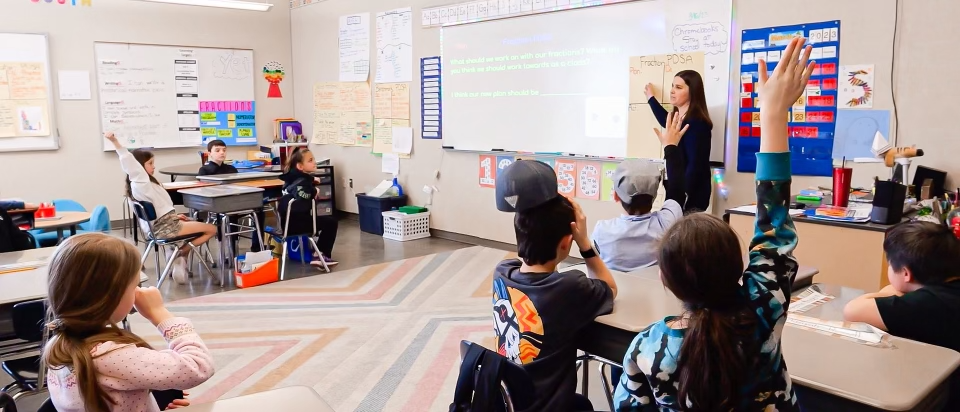
Harnessing Continuous Improvement: PDSA from School Districts to Student-Owned Learning Cycles
Continuous improvement lies at the core of thriving educational systems, and the Plan-Do-Study-Act (PDSA) cycle has emerged as a powerful force shaping positive change. From school boards and superintendents to individual students in the classroom, PDSA provides a structured approach to problem-solving focused on learning and improving.
Incorporating PDSA throughout the entire educational system supports a resolute commitment to intentional problem-solving and continuous learning. Leaders are seeing the results. The system-wide commitment to use regular and frequent PDSA cycles is the driving force behind positive change, enhanced student and staff engagement, and a culture of learning.
PDSA Cycles of Improvement at Each Level
School District
At the district level, the PDSA cycle kicks off with meticulous planning. Improvement goals are set and key performance indicators (KPIs) are identified as stakeholders, including teachers and administrators, actively engaged in the planning process. Identifying strategic actions follows this planning with a focus on execution. Cycles of reflection are built into the calendar to ensure the work stays on track. The study phase involves a comprehensive analysis of both numeric and narrative data related to the effectiveness of the strategic actions and change ideas. Identifying and executing the next actions is based on this analysis; strategies are adjusted, successful practices are shared across schools, and stakeholders are involved in decision-making.
Plan
- Establish improvement goals based on identified areas of need.
- Identify key performance indicators (KPIs) for the district.
- Engage stakeholders, including teachers and administrators, in the planning process.
Do
- Implement strategies aligned with improvement goals.
- Provide professional development opportunities for educators.
- Roll out new programs and assess their impact on district-wide performance.
Study
- Collect and analyze data related to the implemented changes.
- Solicit feedback from teachers, students, and parents.
- Assess the impact on district-wide performance.
- Evaluate the effectiveness of initiatives in achieving improvement goals.
Act
- Adjust strategies based on the analysis of results.
- Share successful practices across schools within the district.
- Communicate findings to stakeholders and involve them in decision-making.
Jennifer Lowery, Superintendent of Tea Area School District, stresses the importance of communicating goals and the PDSA process, “We show people. I have it on my wall. What my goal and my Plan-Do-Study-Act is right now. In this district, we’re going to do Plan-Do-Study-Act, which means our mission and vision are to educate and empower.”
District leaders, inspired by intentional problem-solving, create synergy within the system. As Whitney Holton, Associate Superintendent of Campbell Union School District, emphasizes, this alignment enables leaders to move down to the classroom level, initiating a powerful learning experience.
Holton had the opportunity to attend Destination High Performance (DHP) at the Estacada School District with her team. She shares on a recent Accelerate Your Performance podcast, “In Estacada, we saw classrooms where teachers were leaning into the work. We saw students owning their learning, setting goals. And there was also student lead PDSA cycles.”
The journey doesn’t stop with district leadership. Holton’s experience in Estacada demonstrates the impact of cascading improvement work to the classroom level. This shift empowers students to take charge of their learning through goal setting and engagement in their PDSA cycles.
Classroom
When PDSA improvement cycles cascade into regular classroom practice, students are empowered to become co-owners of their learning. Actively engaged in taking charge of their learning by goal setting, refining their strategies and executing action based on data and feedback. Kate Dean, Instructional Coach at Estacada High School, shares the transformative results: “Every student in the building is being provided multiple opportunities to track their academic progress and set progress goals. The results include an increase in overall student agency, higher learning success rates, and better connections between course content and life skills.”
At the classroom level, the PDSA cycle takes shape through meticulous planning that includes setting learning objectives, designing lesson plans, and considering individual student needs. A key to progress is the teacher clearly communicating success before the learning cycle begins. The “do” or execution phase involves active engagement with students. Strategies are named, tried, and adjusted with a focus on learning. Studying happens regularly and frequently using the easiest measures of change. “What happened? Did we improve? What should we keep doing, stop doing or change?” These regular and frequent pauses guide quick changes to strategies that keep the learning trajectory on track. Using the simplest tools to assess and adjust is where the magic happens. Laura Berg, Continuous School Improvement Coach in the Tea Area School District shares, “I no longer assume I know what my students need. I ask for their input and feedback so we can make adjustments to our learning strategies.” This intentional pause and reflection that includes input from students, those closest to the work informs changes to the classroom learning system. What ACTions should we take that will help us improve? The PDSA process leads to system-wide ownership of learning. Act involves sharing with the students how teaching and learning strategies will be adjusted based on the numeric and narrative data that has been collected.
Plan
- Set learning objectives based on curriculum standards.
- Communicate success before starting.
Do
- Identify and communicate key teaching and learning strategies.
- Execute lesson plans and engage students actively.
- Foster a collaborative and participatory classroom environment.
Study
- Assess student performance through formative and summative evaluations.
- Use the Plus/Delta process to collect feedback from students regarding the learning process.
- Reflect on teaching methods and their impact on student understanding.
Act
- Use numeric and narrative feedback to determine the next actions.
- Execute the next actions.
Gina Sherman, a third-grade teacher in the Estacada School District, provides a tangible example of how PDSA is embraced in the classroom. Gina’s students are not just learning about PDSA; they are living it. They set goals, track data, and witness their growth. Gina’s classroom is a testament to the power of intentional, structured improvement.
From district leaders championing intentional problem-solving to students actively participating in their learning journey, PDSA has become a catalyst for positive change in education. The education system transforms into a dynamic environment where every stakeholder plays a role in continuous improvement. As the walls of classrooms display tangible growth, the journey towards student-owned learning becomes a shared success story, reinforcing the transformative impact of PDSA in education. The intentional and structured approach of PDSA enhances academic success and fosters accountability, empowering educators and students on the journey toward excellence.
KEY TAKEAWAYS
Think differently.
Empower everyone. PDSA cycles provide a structured problem-solving process of Think-Try-Learn-Adjust, encouraging every individual in the district to approach challenges in a structured and intentional way. When embedded throughout every level of the organization, the education system can foster a culture of continuous improvement, engagement, and accelerated success.
Plan differently.
A systematic and systemic approach for achieving educational goals is crucial at all levels, throughout the district. Identifying goals, problems to solve and the key indicators of success are where you start. Determining strategies to try, in small cycles of improvement, and executing on those strategies is critical. Frequent checks along the way ensure you stay the course that leads to “better.”
Act differently.
Numeric and narrative feedback ensures the voice of those closest to the work are heard. As their input can be difference-making. Adapting strategies based on feedback can create a dynamic environment of continuous improvement and learning. This approach boosts academic success and fosters accountability, empowering both educators and students on the path to excellence.
-
Tina Posnanski Leader Coach
-
Casey Blochowiak Vice President of Coaching




